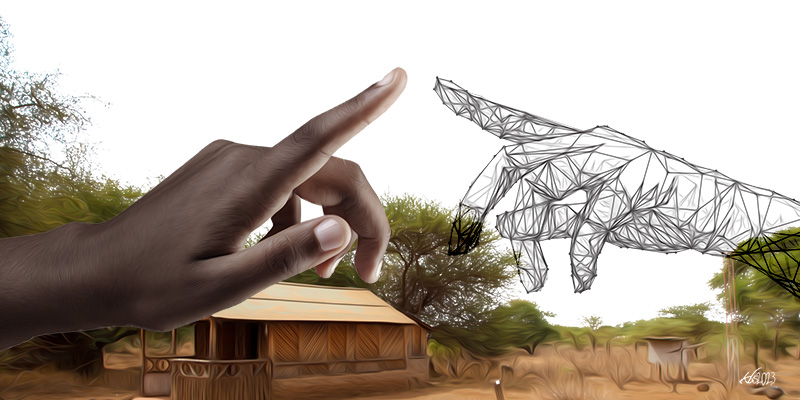London, UK
EIGHT MILLION ACRES OF THE COUNTRY’S BEST LAND
It was a potentially explosive situation. A few hundred white farmers held over eight million acres of the country’s best land, and memories were fresh of a guerrilla war to dispossess them. Over 6,000 British troops had been sent out to protect the farmers and suppress the rebellion in which 37 settlers and more than 10,000 ‘terrorists’ were to die.
The country’s six million-strong African majority, impatient for change, controlled parliament. Full independence from Britain was only months away, and land redistribution was high on the agenda.
‘Is European farming going to carry on?’ asked an anxious writer at the time. ‘Can the country keep going when it turns sound economic farms into subsistence units? Farming and expediency are at loggerheads,’ he concluded gloomily.
The country was Kenya, the time was the early 1960s, and the parallels with Zimbabwe may yet prove instructive as London and Harare seek a way out of their impasse.
Forty years ago, the British government of the day was prepared to be the main contributor to a £20 million land resettlement fund – worth £250 million at today’s prices – to help pay for the redistribution of former white farms in Kenya.
By the time Zimbabwe won Independence in 1980, however, the British government’s purse strings were tighter, although Zimbabwe at Independence had five times as many white farmers.
Britain’s initial contribution to Zimbabwe’s land resettlement programme was £30 million, £75 million at today’s prices. And while a further £14 million was provided, and an additional £36 million has been promised conditionally, in real terms the total UK contribution has been well under half the support given to Kenya.
Although the British thought that Jomo Kenyatta, who later became the country’s founding president, was the driving force behind the Mau Mau, it was he who paved the way to peaceful transition to majority rule when he addressed farmers in the ‘White Highlands’ and assured them of a role in independent Kenya
Yet the history of the two countries has many shared features.
Both countries were British colonies, and the white minority in each – 60,000 in Kenya, 275,000 in Zimbabwe at their peak – expropriated land at the turn of the century and dominated the economy. And both had to come to terms with the rise in African nationalism in the 1950s that was to mark the end of the colonial era.
As in Zimbabwe, land was a sensitive issue in Kenya and at the heart of what became known as the Mau Mau rebellion.
Backed by the Kikuyu, Kenya’s largest ethnic group at the time, it first surfaced in the late 1940s, and gathered in strength. A state of Emergency that was to last until 1960 was declared in 1952, and on the night of October 20 that year the first British battalion arrived. By May the following year there were two British brigades – over 6,000 troops – supported by six battalions of the King’s African Rifles and two RAF bomber squadrons.
KENYATTA PERSUADES WHITE SETTLERS TO STAY
Britain and the settlers were convinced that the driving force behind Mau Mau was Jomo Kenyatta, the man who was to become Kenya’s founding president. Convicted of managing Mau Mau, banned by the colonial administration, he was held in detention for seven years until his release in 1961. Although the British thought that Jomo Kenyatta, who later became the country’s founding president, was the driving force behind the Mau Mau, it was he who paved the way to peaceful transition to majority rule when he addressed farmers in the ‘White Highlands’ and assured them of a role in independent Kenya.
But he also had to meet the demands of another constituency – peasant farmers seeking land. Land reform had got under way in the mid-1950s, but more had to be done. ‘At the approach of Independence,’ writes a contemporary commentator, ‘rising pressures from the landless Kikuyu tribes for farms was combined with the rundown estates in the highlands owned by Europeans, many of whom were anxious to emigrate provided they could recover the capital they had invested in their land.’
Hence the launch in mid-1962 of what became known as the ‘million acre scheme’ financed by Britain, with West Germany and the World Bank providing the balance.
A little over one million acres of land owned by 780 white farmers was purchased, and by the end of 1971, when the scheme was wound up, some 35,000 families had been settled on 1.2 million acres.
Resettlement not only defused political tension. It helped change the structure of Kenyan agriculture, with exports crops such as tea and coffee, previously a white preserve, for the first time being grown in quantity by smallholders
After 1965, the government adopted a different approach. A special commissioner for squatters registered and settled squatters on 10-acre plots carved out of abandoned or mismanaged white farms that had been taken over.
By the mid-1980s, these squatter schemes, together with the million acre scheme, had settled over 71,000 families on nearly 2 million acres of land – about 17 per cent of all land originally held by white farmers.
‘Without such a plan, undoubtedly there would have been a breakdown in race relations, and violence and theft on a very large scale and a collapse in the general economy,’ writes the commentator.
Resettlement not only defused political tension. It helped change the structure of Kenyan agriculture, with exports crops such as tea and coffee, previously a white preserve, for the first time being grown in quantity by smallholders.
A STORY OF MIXED SUCCESS
The story of the intervening decades is one of mixed success, however. Although one third of the purchase price under the million acre scheme was met by UK grants, the farmer had to repay the balance over 30 years. For many this proved too much, and they were replaced by larger farmers, businessmen or the urban political elite.
LAND REMAINS AT THE HEART OF THE COUNTRY’S POLITICS
A few years after Independence. Kenyatta made Kenya a one-party state, and corruption and mismanagement took their toll.
The size of plots is shrinking by the year under pressure from population increase, and the demand is increasing for the subdivision of the many large farms that remain in the hands of politicians and businessmen
Meanwhile land remains at the heart of the country’s politics: The size of plots is shrinking by the year under pressure from population increase, and the demand is increasing for the subdivision of the many large farms that remain in the hands of politicians and businessmen. Above all, the number of landless Kenyans is over two million and rising.
Nevertheless, Kenyans with long enough memories must be looking back on their own history and giving thanks that they lived in times when Britain was able offer a big carrot, as well as wield a big stick.








